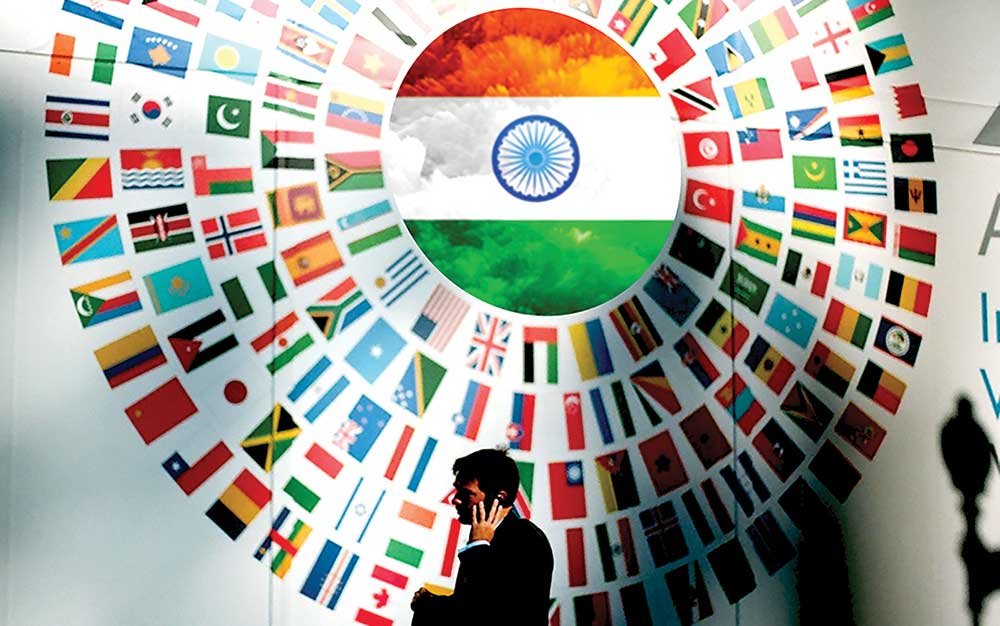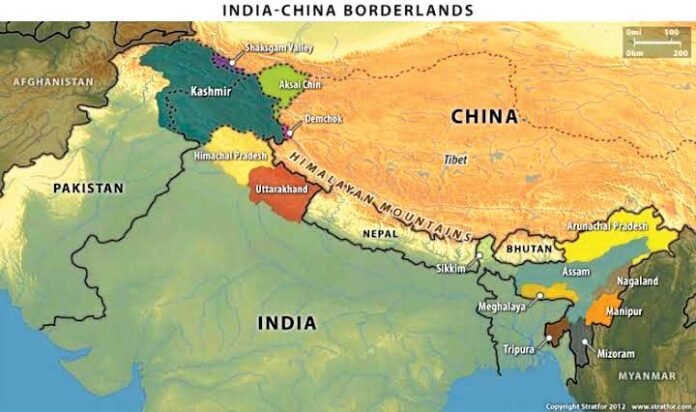India today stands at a pivotal strategic crossroads—encircled by converging threats and evolving battlefronts. The prospect of future wars being fought on multiple fronts is no longer hypothetical; it is a looming reality, sharpened by China’s assertive expansionism, collusive threats from Pakistan, and instability across its maritime and continental peripheries. As Beijing deepens its hybrid, grey-zone, and psychological warfare, India’s traditional postures of strategic restraint and reactive diplomacy appear increasingly inadequate.
To navigate this matrix of discomfort, India must undertake a dual recalibration: first, by forging a coherent, forward-leaning military doctrine tailored to 21st-century warfare; and second, by transforming its foreign policy discourse—from accommodation and ambiguity to assertiveness and alignment. The cost of inertia is rising; clarity is now a strategic necessity.
The world is drifting into an era of fractured alignments and fluid escalations. In Europe, the Ukraine-Russia war has rewritten the rules of deterrence, showing how attrition, economic isolation, and drone warfare can all redefine conventional superiority. In the Middle East, the simmering conflict between Israel and Iran—often spilling into Syria, Lebanon, and the Red Sea—threatens a regional conflagration. The United States, torn between global commitments and domestic fatigue, is recalibrating its leadership posture, often amplifying strategic vacuums.
Meanwhile, the Indo-Pacific is turning into a fulcrum of power struggle, with Taiwan and the South China Sea as the focal points. China’s muscle-flexing in the region and its ambition to reorder global governance mechanisms are no longer veiled. Amidst this, India’s neighbourhood has grown more fragile and volatile. Along the Line of Actual Control (LAC), China’s tactical incursions are part of a long strategic game. Pakistan, emboldened by Beijing’s backing, continues to act as a willing disruptor. The growing Chinese footprints in Nepal, the Maldives, and Sri Lanka have transformed India’s periphery into a contested strategic buffer. The matrix of discomfort facing India is not only multidimensional—it is intensifying at a pace that outstrips India’s institutional agility.
India’s Strategic Posture and Its Limitations
India’s current strategic posture has been shaped by a legacy of strategic restraint—an approach that once enabled the country to prioritise growth, avoid entanglements, and preserve autonomy. But today, this very posture is beginning to show fatigue. India’s security architecture remains largely land-centric, with a primary focus on holding territory rather than imposing costs. Our adversaries, meanwhile, have shifted the battlefield into the grey zones of cyber, information, space, and economic coercion.
Despite structural changes like the appointment of the Chief of Defence Staff (CDS), true tri-service integration remains elusive. Military planning still occurs in silos, procurement is fragmented, and inter-theatre coordination is embryonic. India’s strategic ambiguity—once considered prudence—is increasingly being perceived as indecision. Diplomatically, India walks a careful line between the West and Russia, between the Indo-Pacific and Eurasia. But in a world of sharp power projection, caution without coherence risks irrelevance.
The problem is not of will or capability, but of strategic articulation. Without a codified national doctrine and integrated civil-military interface, India risks being tactically reactive and strategically disjointed. The time for hedging has passed; the time for hard choices has arrived.
Adversaries have moved beyond traditional warfare, exploiting cyber, economic, and psychological domains. India’s security architecture, still focused on territorial defence, must evolve to impose costs across these new battlefronts—or risk strategic irrelevance
Understanding China’s Long-Term Strategic Aims
To understand the Chinese threat, one must look at the mindset that drives it—calculated, historical, and unapologetically expansionist. China’s long-term objective is strategic primacy in Asia, and that vision cannot tolerate a resurgent, autonomous India.
Unlike Pakistan, China does not seek to provoke India into open war. Instead, it prefers incremental encroachment—salami-slicing land, building influence in India’s neighbourhood, and boxing India in through ports, highways, debt diplomacy, and digital dominance. From the LAC to the Indian Ocean, from Sri Lanka to the Himalayas, Beijing’s tactics are calibrated to apply pressure without breaching the threshold of war.
China also pursues narrative control—undermining India’s global standing by blocking Nuclear Suppliers Group (NSG) membership, resisting United Nations Security Council (UNSC) reforms, and marginalising India in forums like BRICS (Brazil, Russia, India, China, and South Africa). Its deployment of surveillance infrastructure and its strategic partnerships in South Asia are aimed not just at military advantage but at influencing political choices in India’s extended neighbourhood.
India, for China, is not just a military rival—it is a civilisational competitor. And in this grand contest, it’s not just territory that is at stake—it is the very definition of Asian leadership.
Doctrinal Clarity—Why India Needs It Now
Doctrine is not a luxury in modern warfare—it is a lifeline. India cannot afford to improvise its response every time the adversary shifts the playing field. A coherent doctrine is the bedrock of national preparedness—it defines the nature of threats, the thresholds of response, and the principles of deterrence.
Operation Sindoor was a telling reminder: when political will, inter-service coordination, and precise execution come together, India can act with purpose and impact. But that operation was exceptional—successful despite the absence of doctrinal codification. To replicate such outcomes consistently, India must stop relying on individual brilliance and start depending on institutional clarity.
Our doctrine must evolve to reflect the realities of today’s battlefield, which is no longer restricted to terrain and troops. We need a multi-domain doctrine that integrates space, cyber, artificial intelligence (AI), electronic warfare, and perception management. We must be prepared not just for limited wars and surgical strikes, but also for cognitive and economic warfare, as demonstrated in Ukraine, Syria, Israel-Gaza, and Iran’s regional playbook.
Most importantly, India’s military doctrine must shift from “hold and deny” to a more dynamic triad of:
- Deterrence by denial (make aggression costly),
- Deterrence by punishment (hold adversaries accountable across domains), and
- Strategic manoeuvring (pre-emptive deployments, rapid force projection, and narrative dominance).
India must declare what it will not accept, what it will respond to, and how it will calibrate its retaliation. A doctrine is not just military—it’s the strategic conscience of the nation.
Modern deterrence requires more than military might. A dynamic triad of denial, punishment, and strategic manoeuvring—spanning AI, space, and electronic warfare—must replace outdated Cold War-era postures
The Case for Foreign Policy Realignment
Foreign policy cannot remain rooted in yesterday’s map. In a world of real-time threats and fluid alliances, India must adopt what statisticians describe as a Bayesian approach—where strategies are constantly updated based on new information and evolving realities.
India’s traditional model of hedging—being everywhere but committing nowhere—is no longer sustainable. The world respects clarity. India must move from an era of strategic non-alignment to an age of principled alignment. This means embracing partnerships not just for trade, but for tech, logistics, and security. The Quadrilateral Security Dialogue (Quad) must move from dialogue to deterrence. The India-Middle East-Europe Economic Corridor (IMEC) must evolve from blueprint to backbone. Engagement with Europe must be rooted in shared values, not just market access.
Regionally, the Neighbourhood First policy must become Neighbourhood Forward—where India offers not just aid, but security, resilience, and infrastructure alternatives to China’s Belt and Road Initiative (BRI). In the Indian Ocean, India must become the net security provider it aspires to be—through bases, training missions, and logistics diplomacy.
The future foreign policy doctrine of India must rest on three pillars:
- Assertive Alignment with like-minded powers,
- Regional Leadership through capability and credibility, and
- Narrative Sovereignty, projecting India as a civilisational force aligned with global stability.
In this world of blurred battlelines and weaponised dependencies, foreign policy is no longer an extension of war—it is its deterrent twin.

Way Forward: Strategic, Military, and Diplomatic Recommendations
Vision must now yield to action. The first step is the urgent release of a National Security Strategy that unifies doctrine, foreign policy, internal stability, and technological preparedness into a single framework.
Next, India must embed a culture of war-gaming and red-teaming across the services and ministries. Simulation-led decision-making, informed by scenario-based data, must replace intuition-based planning. The proposed theatre commands must not just coordinate—they must operate as agile combat hubs, empowered by real-time intelligence, surveillance, and reconnaissance (ISR) and digital battlefield systems.
On the military front, India must fast-track its Aatmanirbhar defence agenda in semiconductors, space surveillance, quantum communication, and drone swarms. Doctrinal clarity must be matched by technological readiness.
Diplomatically, India must lead with confidence—scaling up defence diplomacy, hosting multilateral wargames, providing humanitarian assistance, and shaping maritime governance norms. Every Indian action—be it in Sri Lanka, Africa, or Southeast Asia—must reaffirm its role as a responsible and resolute power.
In essence, if the doctrine defines the “what,” and foreign policy sets the “where,” then this stage is about the “how.” The world is moving fast. India can no longer afford to be cautious in strategy and bold only in hindsight.
The writer is an Indian Army veteran and expert in Operations Research and Systems Analysis






